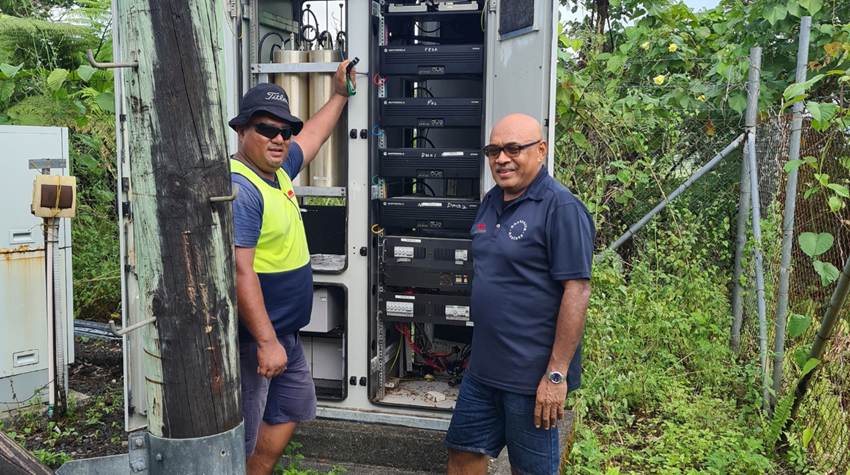Preparedness is an essential part of the disaster management cycle. Efficiently preparing for an emergency can make responses more effective, saving more lives. In Samoa, part of being prepared means having emergency sirens at the ready and making sure that the emergency radio network is working properly.
Samoa, like other Pacific nations, is vulnerable to many hazards. These include tsunamis, fire, flooding and cyclones. A robust warning system is key to ensuring the local population has enough time to evacuate before an emergency hits, saving lives and property. To ensure they can give the community as much warning as possible, the Samoan government installed emergency sirens on the main island of Upolu in 2014. There are now plans to install more sirens in Savai’i.
Patrick is an Emergency Networks Communications Specialist with Australia Assists, arriving in Samoa in April. He is working with Samoa’s National Disaster Management Office to inspect and maintain the emergency networks, providing any training materials needed for their continuing operation.
In the few months since he arrived on-island, Patrick has already experienced several emergency events. ‘We’ve had a few significant earthquakes,’ says Patrick. ’We’re close to the Ring of Fire here, the area of the Pacific where most of the world’s earthquakes and volcanoes occur. Savai’i has a volcano that is partially dormant, sometimes people can see it smoking.’ Savai’i is the larger of Samoa’s two islands, and this month has experienced dangerous flooding.
’Samoa is also in the path of cyclones, and there have been a few major ones in the past 10 years or so,’ Patrick continues. ’They had a tsunami in 2009 after two earthquakes occurred within 2-3 minutes of each other. The 22 metre waves left nearly 200 people dead. That’s part of being in the Pacific. Earthquakes happen here every day. I’ve been monitoring the earthquake activity in the past three days. There has been some activity, and it’s getting shallower. So, we need to be vigilant.’
As this month’s flooding in Savai’i proves, Samoa needs to prepare for more than earthquakes and tsunamis. ‘With climate change, if our home island or country gets flooded due to sea level rise, we’ll have to move,’ Patrick says. ’For the Pacific peoples, once you move from your land to another land, a part of you just dies. You lose your identity, you long to go back. The Australia Assists program, covering a whole range of areas, is helping to prevent this loss.’
With all of Samoa’s vulnerabilities, Patrick’s work on maintaining the emergency sirens and radio system is crucial, as is partnering with Samoan officers to build capacity. The tropical Samoan humidity and salty sea spray make maintaining the emergency network difficult. So too does the thick green vegetation covering the island and the rugged mountains, making the radio network infrastructure hard to access. The availability of spare parts, specific expertise, monitoring capacity and enforcement of processes on testing and maintenance are further challenges Samoa faces.
Localisation: Pacific Skills to meet Pacific Challenges
Patrick not only brings technical expertise to the role, as a fellow Pacific Islander, he also brings cultural understanding. From Fiji, Patrick is one of Australia Assists’ new roster of Pacific professionals, deploying to Pacific countries.
‘This program is a really, really good program,’ enthuses Patrick. ‘For far too long in the Pacific, we have had these challenges with natural disasters and climate change. We need to protect the islands, the people, the cultures and traditions. By supporting local expertise, Australia Assists helps with all of that, by supporting the people, cultures and way of life.’
Patrick says Australia Assists’ commitment to putting localisation into practice is crucial for all sustainable partnerships going forward. ‘It’s very important. The Pacific people have been intertwined through our historical migration across the Pacific. All the countries in the Pacific have some sort of connection, the ancestors of those living now passed through all those other countries in their migration across the Pacific in their big canoes. So, we’re all connected or related.’
‘To work in the Pacific is helping each other, which is a good thing. I believe that, being from the Pacific and working in the Pacific, when you go to one of the other countries you are readily accepted into the culture, they identify with you. This is very important especially as people are more open to you when expressing themselves, which is good, it makes the job much easier.’

‘There are a lot of qualified people in the Pacific. There are a lot of Pacific people working for the United Nations, and a lot of other international organisations around the world. They’ve gone overseas because they didn’t have a place to share their skills and expertise in the region,’ Patrick explains. ’Before the Australia Assists Program came up with the localisation action plan, most of the experts and consultants deployed to the Pacific came from outside, which didn’t represent the local culture. The Program commitment to localisation is a very good and welcome move.’
Learn more about Australia Assists and the work of deployees before, during and after crises.


